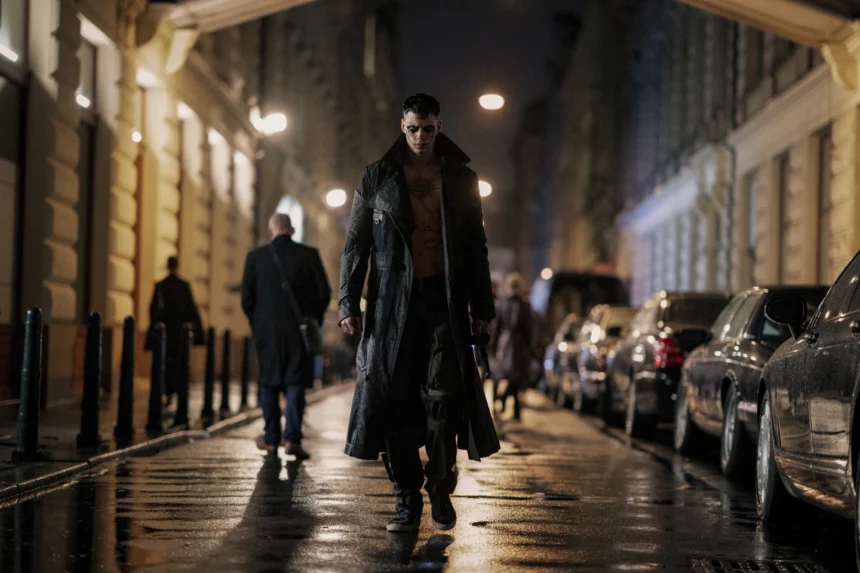The reimagined The Crow opens with a striking image: a fallen white horse, bleeding and trapped in barbed wire in a muddy field. This metaphor, though powerful, feels forced and is never fully explained, setting the tone for the film’s prioritization of style over substance. Director Rupert Sanders, in his effort to breathe new life into the cult classic, seems to have favored visual appeal at the cost of narrative depth and coherence.

Set in a modern, nondescript European landscape, the film makes clear its roots in James O’Barr’s graphic novel. However, the shadow of the 1994 adaptation starring Brandon Lee looms large. Brandon, the son of Bruce Lee, tragically died at 28 after being accidentally shot while filming The Crow. His untimely death and the legacy of the original film continue to resonate, influencing everything from gothic fashion to modern action cinema, and casting a long shadow over this new adaptation.
Bill Skarsgård seizes Lee’s role of Eric Draven, a man so in love that he returns from the dead to revenge his and his sweetheart’s slayings in what can be best called a sort of supernatural, romantic murderfest. (The tagline, “True love never dies,” clumsily rips off Andrew Lloyd Webber’s “The Phantom of the Opera.”)
William Schneider, who co-wrote the screenplay with Zach Baylin, has given the story a near-operatic facelift, by introducing a devil, a Faustian bargain, blood-on-blood oaths and a godlike guide who monitors the limbo between heaven and hell, which looks like a disused, weed-covered railway station. “Kill the ones who killed you and you’ll get her back,” our hero is told.
Advertisement
The first half drags at it sets the table for the steady beat of limbs and necks being detached at the end. Eric and his love, Shelly (played by an uneven FKA Twigs), meet in a rehab prison for wayward youth that is so well lit and appointed that it looks more like an airport lounge where the cappuccinos are $19 but the Wi-Fi is complimentary.
Eric is a gentle loner — tortured by a past the writers don’t bother filling in, who likes to sketch in a book (universal cinema code signaling a sensitive soul) and is heavily tattooed (he’s often shirtless). His apartment has rows of mannequins with their heads covered in plastic and his new love calls him “brilliantly broken.” He’s like a Blink-182 lyric come to life.
Shelly is more complex, but that’s because the writers maybe gave up on giving her a real backstory. She has a tattoo that says “Laugh now, cry later,” reads serious literature and loves dancing in her underwear. She clearly comes from wealth and has had a falling out with her mom, but has also done an unimaginably horrible thing, which viewers will learn about at the end.
Advertisement
Part of the trouble is that the lead couple cast off very little electricity, offering a love affair that’s more teen-like than all-consuming. And this is a story that needs a love capable of transcending death.
There are lots of cool-looking moments — mostly Skarsgård in a trench coat, stomping around the desolate concrete jungle in the rain at night — until “The Crow” builds to one of the better action sequences this year, albeit another one of those heightened showdowns at the opera.
By this time, Eric has donned the Crow’s heavy eye and cheek makeup. He adds to this ensemble a katana and an inability to die. As he closes in on his target, mowing down tuxedoed bad guys as arias soar, the group movements on stage are echoed by the furious fighting backstage. A few severed heads might be considered over the top at curtain call, but subtlety isn’t being applauded here.
If the original was plot-light but visually delicious, the new one has a better story but suffers from ideas in the films built on its predecessor, stealing a little from “The Matrix,” “Joker” and “Kill Bill.” Why not create something entirely new?
Advertisement
“The Crow” isn’t bad — and it gets better as it goes — but it’s an exercise in folly. It cannot escape Lee and the 1994 original even as it builds a more allegorical scaffolding for the smartphone generation. To use that very first metaphor, it’s like the trapped white horse — held down by its own painful past, never free to gallop on its own.
